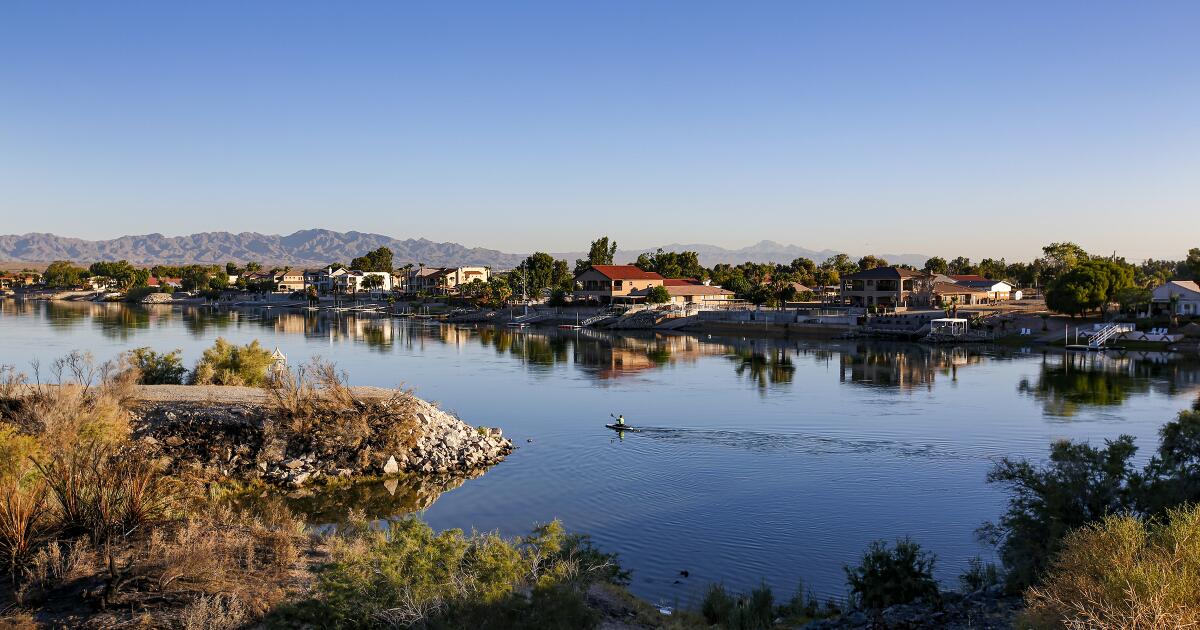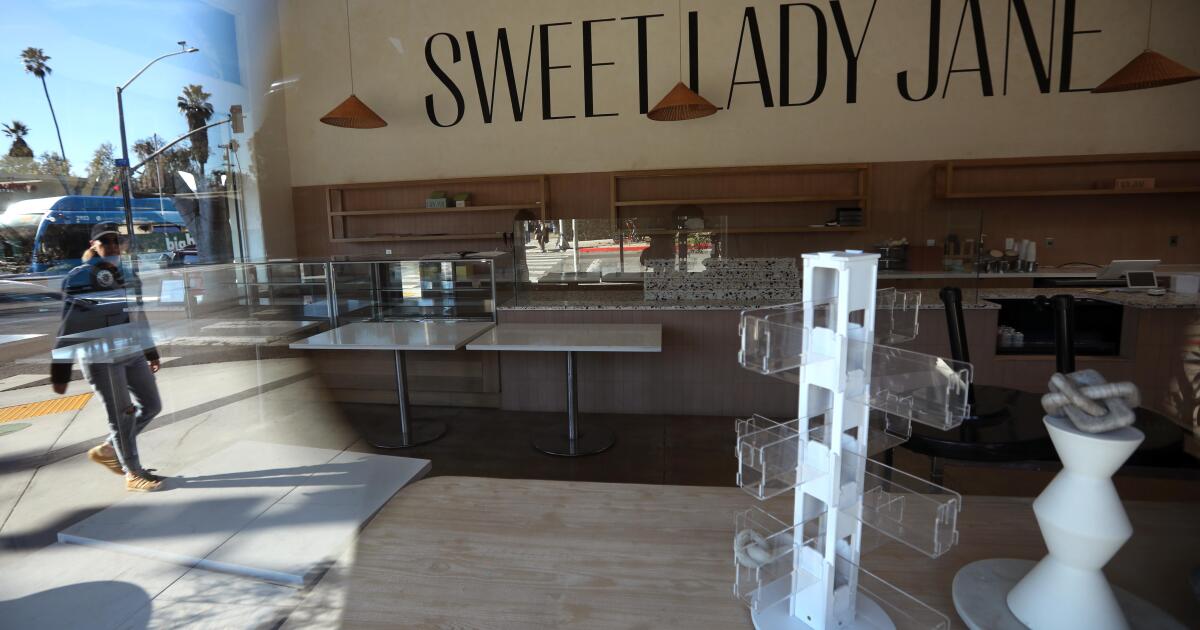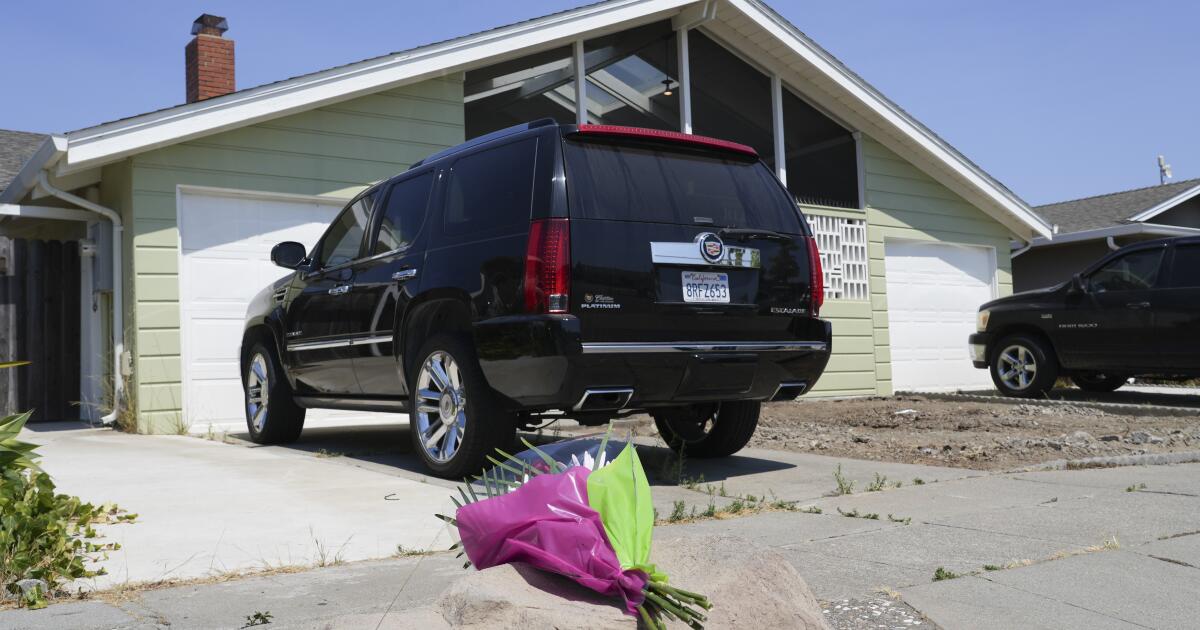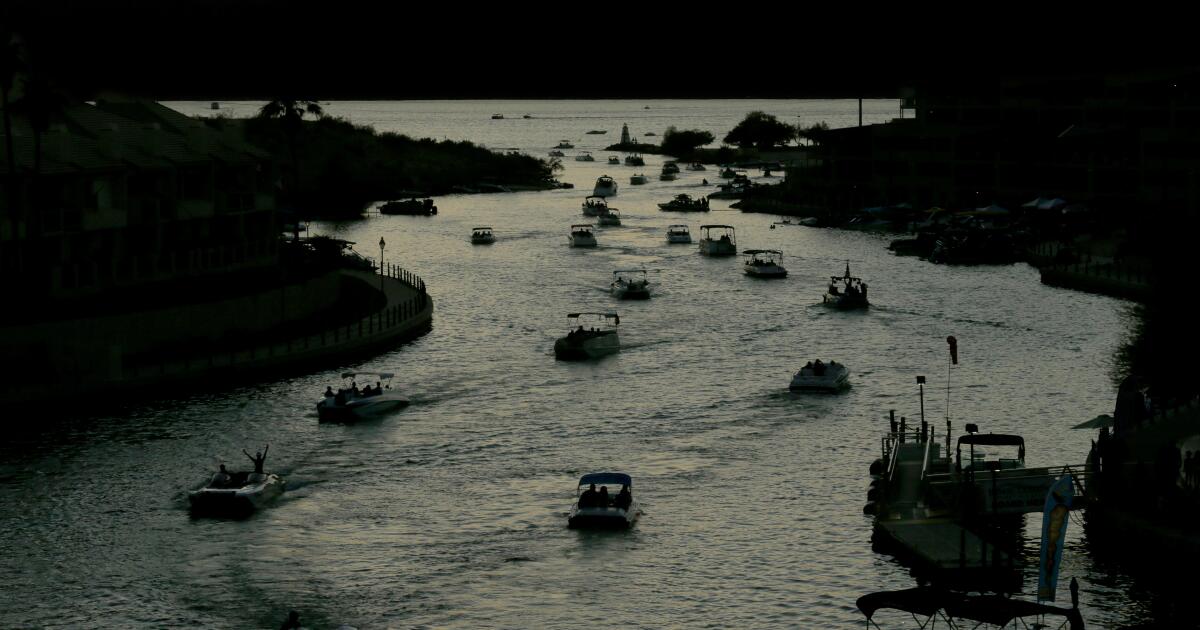World News
How Death Valley National Park tries to keep visitors alive amid record heat
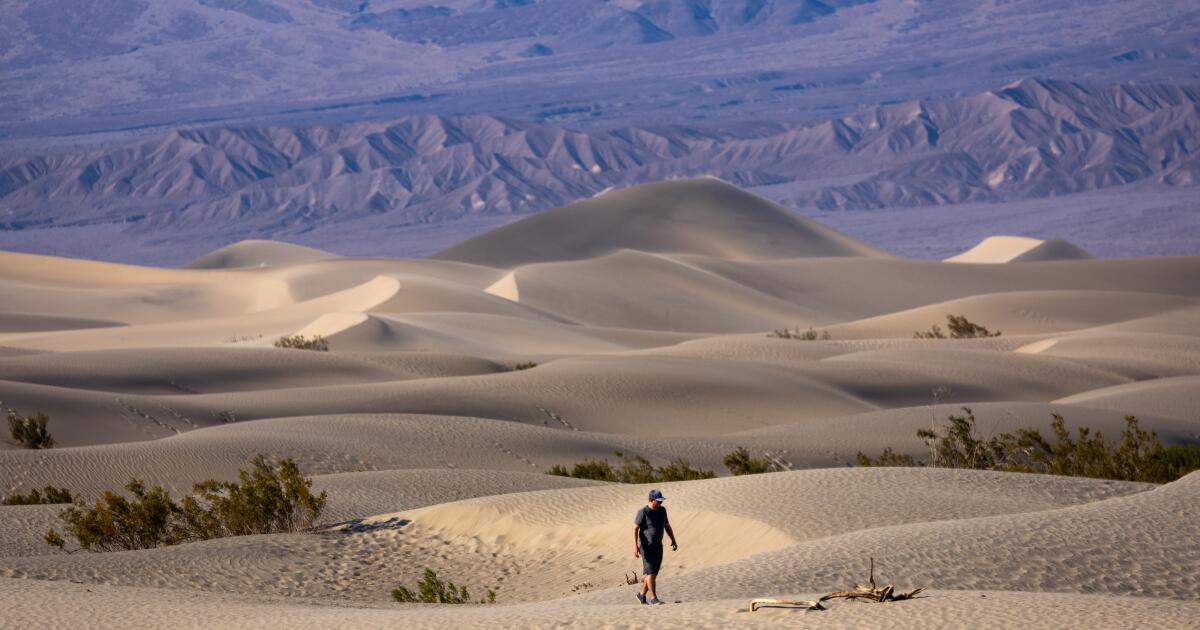
As temperatures swelled to 128 degrees, Death Valley National Park rangers got a call that a group of six motorcyclists were in distress. All available medics rushed to the scene, and rangers dispatched the park’s two ambulances.
It was an “all-hands-on-deck call,” said Spencer Solomon, Death Valley National Park’s emergency medical coordinator. The superheated air was too thin for an emergency helicopter to respond, but the team requested mutual aid from nearby fire departments.
They arrived Saturday to find one motorcyclist unresponsive, and medics labored unsuccessfully to resuscitate him. Another rider who had fallen unconscious was loaded into an ambulance, where emergency medical technicians attempted to rapidly cool the victim with ice as they transported him to an intensive care unit in Las Vegas. The four other motorcyclists were treated at the site and released.
With record heat blanketing California and much of the West recently, Death Valley has hit at least 125 degrees every day since the Fourth of July, and that streak isn’t likely to change until the weekend, according to the National Weather Service.
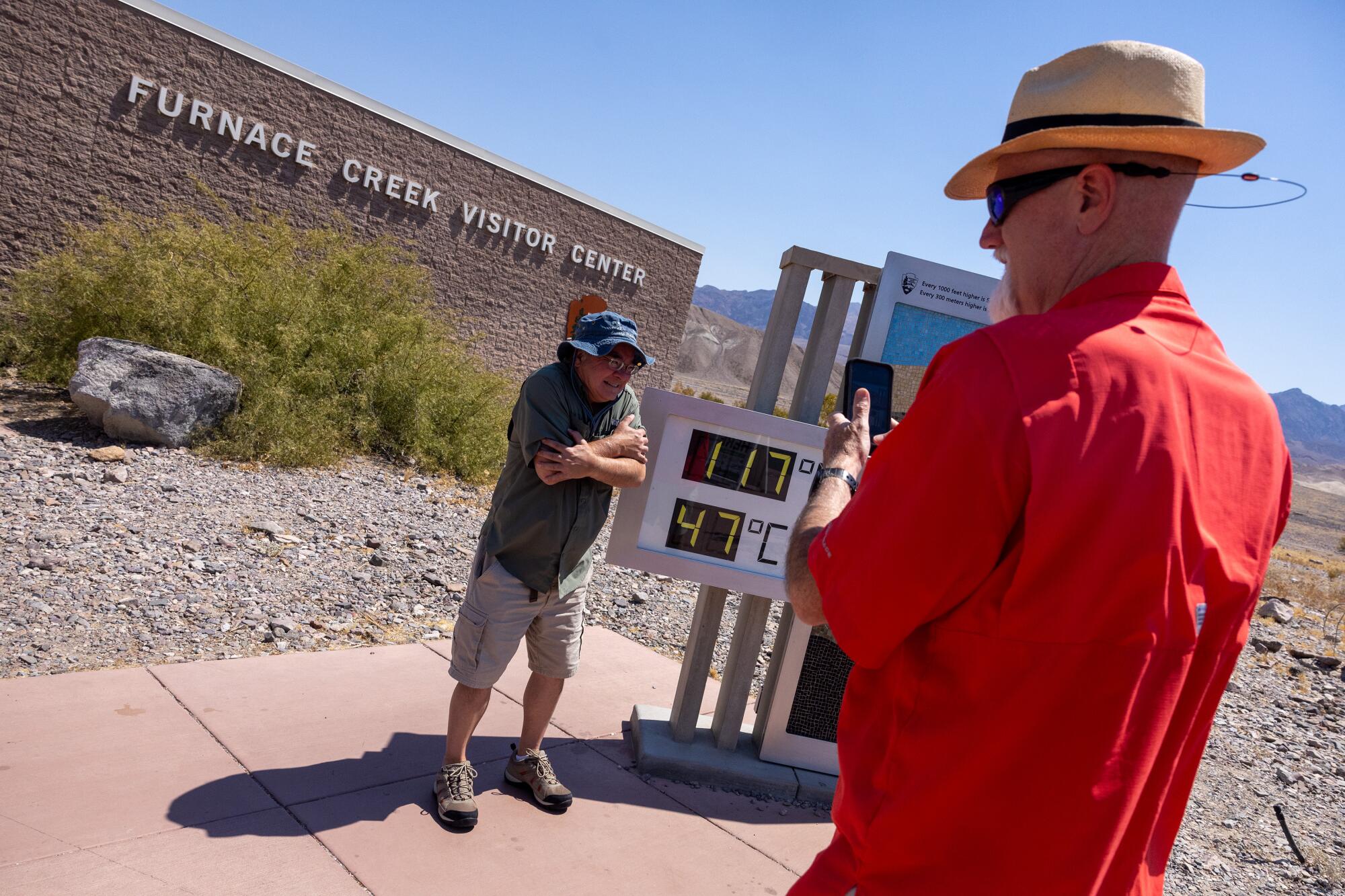
Tourist Dave Hsu, left, feigns a chill as friend Tom Black takes a photograph at the Furnace Creek Visitor Center’s digital thermometer.
Extreme heat is both one of Death Valley’s greatest intrigues and its most serious safety concern. It’s not uncommon for a few people to die in the park from heatstroke in any given summer.
Located 200 feet below sea level and surrounded by steep, towering mountain ranges that trap heat, the valley is consistently among the hottest places on Earth.
In the summer, international travelers often schedule their trips without considering the weather. (All six of the men who fell victim to extreme temperatures near Badwater Basin on Saturday were from Germany.)
But even Southern California residents who are familiar with Death Valley’s hellish reputation will trek to the park just to experience the otherworldly heat.
“In L.A., people said, ‘No, don’t go out there; you’re crazy,’” said Nick Van Schaick, who visited the park early this week. He had spent the night in the nearby town of Beatty, Nev., then drove into the park at the crack of dawn Tuesday. “I don’t know. … There’s something compelling about this landscape.”
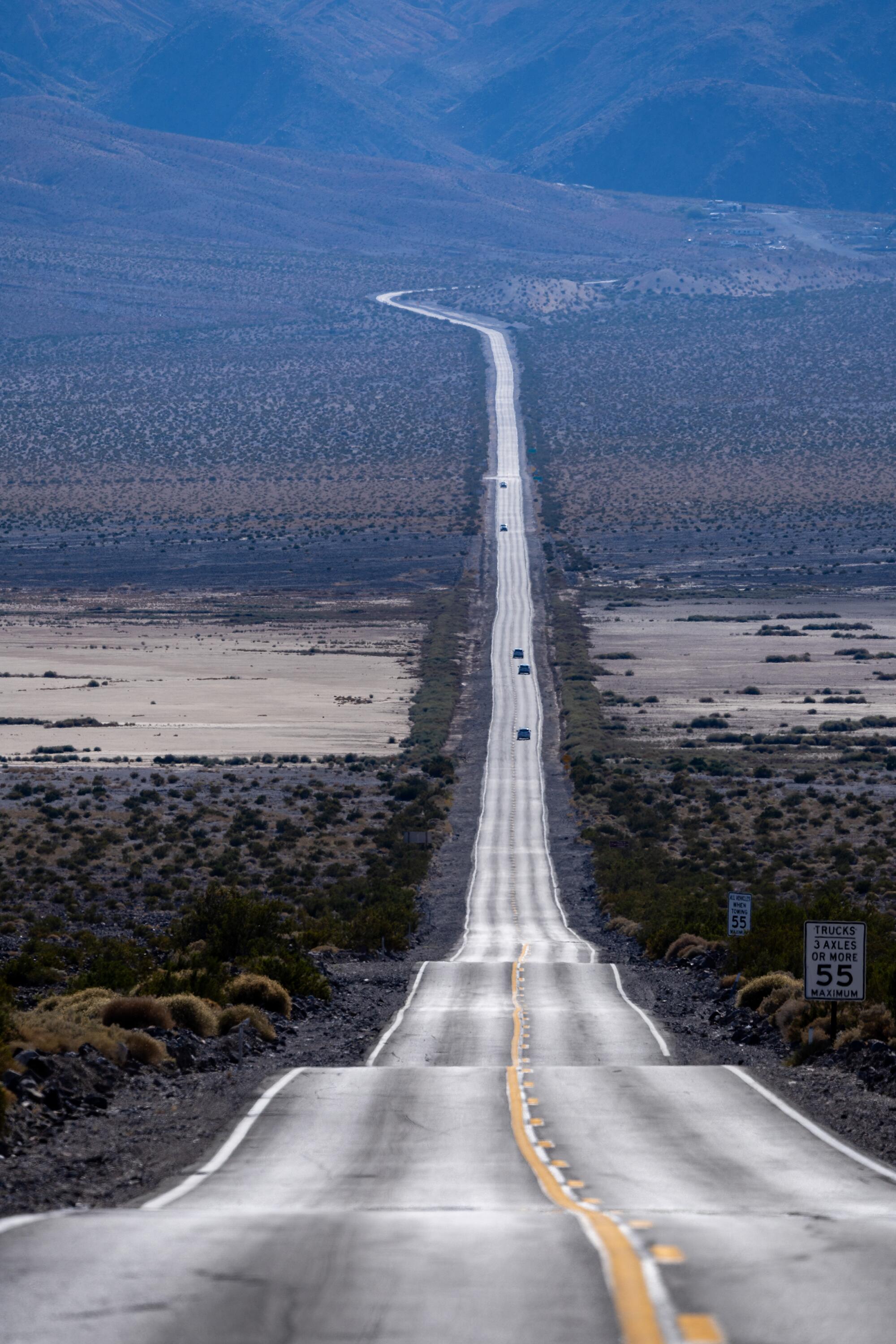
Visitors to Death Valley National Park drive in and out of the park on Highway 190 through the Panamint Valley, where temperatures were as high as 125 degrees recently.
Virtually all heat-related deaths are preventable, experts say, but what makes heat so dangerous is that it sneaks up on its victims.
The risk of Death Valley’s heat seems painfully obvious. It’s hard to miss the dozens of “Heat kills” signs throughout the park, and stepping out of a car there for the first time feels like sticking your face in an opened oven. Within seconds, your eyes begin to burn and your lips crack. Your skin feels completely dry — even though you’re sweating profusely, the sweat evaporates almost instantaneously.
But one of the first symptoms people experience as their core temperature begins to rise is confusion, which can inhibit a person’s ability to recognize that something is wrong or understand how to save themselves.
Studies have also shown that although almost everyone understands how to prevent heat illness, too few take action to protect themselves. That’s in part because many think they are uniquely able to handle the heat when in fact they are not. In 2021, a Death Valley visitor died from heat just days after another visitor had died on the same trail.
It’s a one-two punch. Hikers ignore the symptoms of heat exhaustion because they’re excited to hike or have nowhere else to go, said Bill Hanson, an instructor for Wilderness Medical Associates International and a flight paramedic in central Texas who specializes in heat-related emergencies. Then, “when a person reaches a pretty profound state of heat exhaustion — which by itself is not a lethal condition — and they’re still in that environment, the likelihood they’ll make the right decisions and reverse the process … is reduced because they have a reduced ability to make good decisions at all.”
One of the reasons that humans are quickly overcome by extreme heat is that there’s only one route for heat to exit the body. Blood carries heat from our core to our skin, and, when the breeze is too hot to carry heat away from us, the body can release it only through the evaporation of sweat. Any of that sweat that drips to the ground or is wiped off the face is a missed opportunity to cool down.

Visitors walk out onto the salt flats at Badwater Basin, taking advantage of cooler morning temperatures on a day when the mercury would rise as high as 125 degrees in Death Valley National Park.
In Death Valley, the air is so dry that sweat evaporates very easily, unlike in humid climates where the atmosphere contains more moisture. With profuse sweating, however, dehydration comes quickly. The park recommends visitors do their best to replenish lost water and drink at least a gallon a day if they’re spending time doing any physical activity outside.
But sweating and constant hydration will work only to a point.
“A 130-degree environment … there’s going to be a limited shelf life on a human body’s ability to exist in that environment without some technological support,” Hanson said.
Because of this, the park says to never hike after 10 a.m. during periods of extreme heat and recommends never straying more than five minutes away from the nearest air conditioning, whether it be in a car or building.
In the heat, sticking in groups can also save lives. While it might be difficult for a confused heat illness victim to recognize the symptoms or remember how to save themselves, friends can spot problems. In general, if you struggle to do anything that is normally easy for you — physically or mentally — stop to rest and seek cooler conditions immediately.
Muscle cramps are often the first sign the body is struggling to stay cool. They’re probably caused by a toxic concoction of dehydration, muscle fatigue and a lack of electrolytes like sodium, which are essential for chauffeuring water and nutrients throughout the body. Cramps are a sign that the body’s process for dumping heat is under stress.
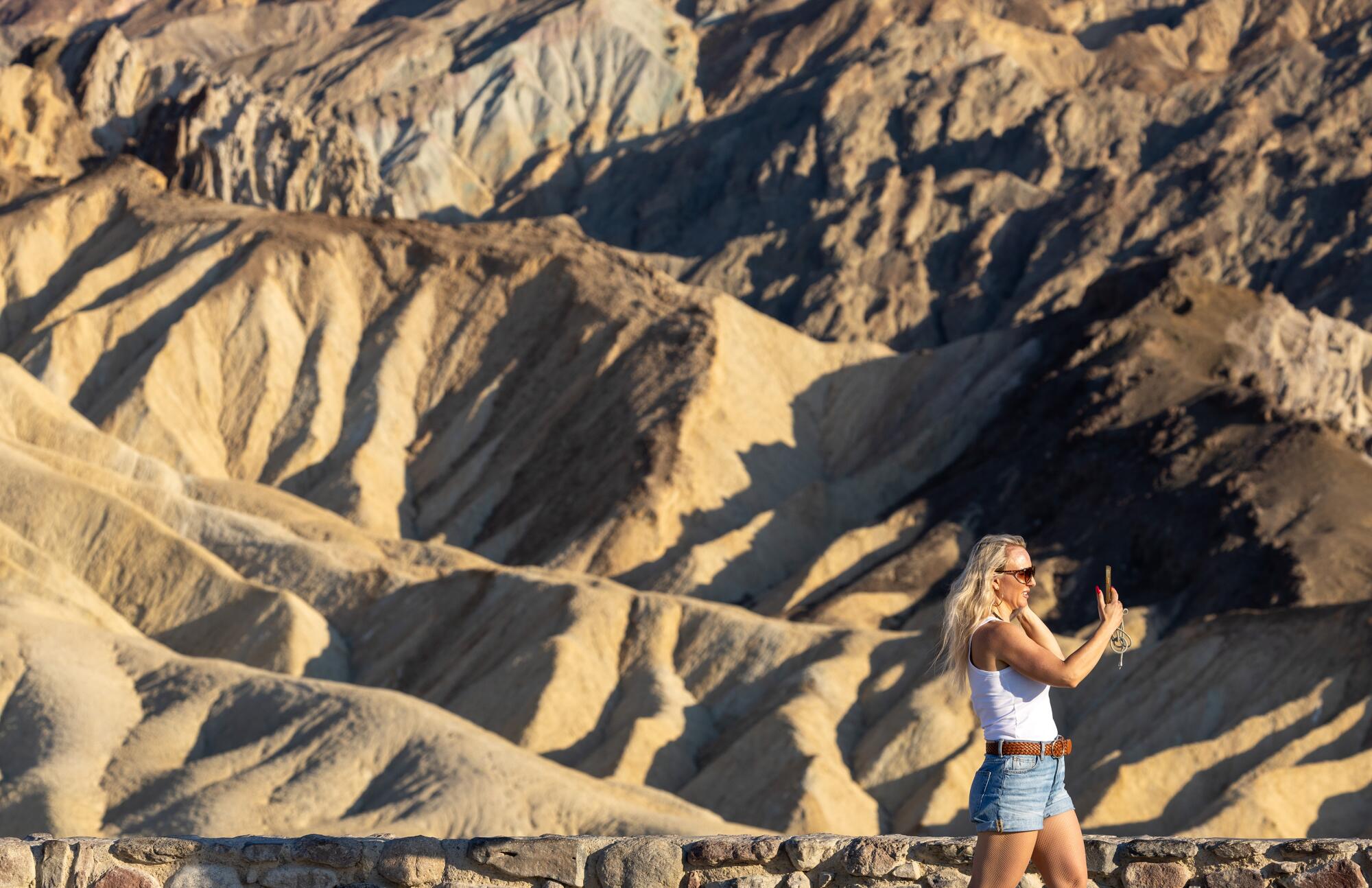
Death Valley National Park visitor Steffi Meister, from Switzerland, photographs the landscape at Zabriskie Point where temperatures were as high as 125 degrees recently.
As the body struggles, heat exhaustion starts to set in. The brain, heart and other organs become tired from working to maintain the body’s typical temperature of 98 degrees. As the body passes 101 degrees, victims can start experiencing dizziness, confusion and headaches. It’s not uncommon for them to vomit, feel weak or even faint.
As the body passes 104 degrees, the entire central nervous system — responsible for regulating heat in the first place — can no longer handle the stress of the high temperatures. It starts to shut down. The victim might get so confused and disoriented that they no longer make sense. They might not even be able to communicate. They can start to have seizures and fall into a coma.
“To me, as a park medic, if you’re unresponsive, you’re going to the hospital,” Solomon said, “because your brain is essentially cooking.”
At this point, the heat has done irreversible damage that can leave the victim disabled for years to come. If internal temperatures don’t fall quickly, death becomes a very real possibility. Organs can fail within hours, killing the victim, even after their temperature starts to drop.
Heat illness can come on within just minutes or take hours to develop. “There’s kind of a weird phenomenon where there’s two times of day where we’ll get 911 calls for people who have fallen ill” due to heat sickness, Solomon said.
One is in the middle of the afternoon, when the heat is at its worst. The other is near 11 p.m. — visitors will feel OK during the day, but get increasingly dehydrated as they continue to exert themselves. “Then, they check into their hotel room and fall ill,” Solomon said.
In some extreme cases, heatstroke can overwhelm a person so fast that muscle cramps and other symptoms of heat exhaustion don’t have time to show. The Death Valley emergency response team typically gets about two or three heat illness calls per week in the summer, with visitors experiencing symptoms across the spectrum from mild fatigue to loss of consciousness.
Heatstroke experts overwhelmingly agree on the most effective treatment: cooling the patient as fast as possible.
“The key to survival is getting their body temperature under 104 within 30 minutes of the presentation of the condition,” said Douglas Casa, a professor of kinesiology at the University of Connecticut and the chief executive of the Korey Stringer Institute, a leading voice in treating heatstrokes. “It’s 100% survivability if you do that, which is amazing because there’s not too many life-threatening emergencies in the world that have 100% survivability if treated correctly.”
The fastest way to cool a patient is a cool ice bath, experts say. Hanson said his team in Texas will fly an ice bath on a helicopter and cool the victim in the middle of the desert until their temperature stabilizes before the medics even transport them.
However, in Death Valley, getting an ice bath to victims can be nearly impossible. The hot air is so thin that the team can’t fly helicopters. Instead, they bring a body bag and cool the victim inside with ice and cool towels as they’re transported via ambulance.
Although emergencies are regular, the park says they are preventable, and if people follow park guidance, they can experience the heat safely.
“It really is a reason why some people come to visit — because this is one of the few places on Earth where you can feel what that level of heat feels like,” said supervisory park ranger Jennette Jurado. “It’s our job as park rangers to do our very best to make sure people can have these experiences and then go home safely at the end of the day and remember these experiences.”
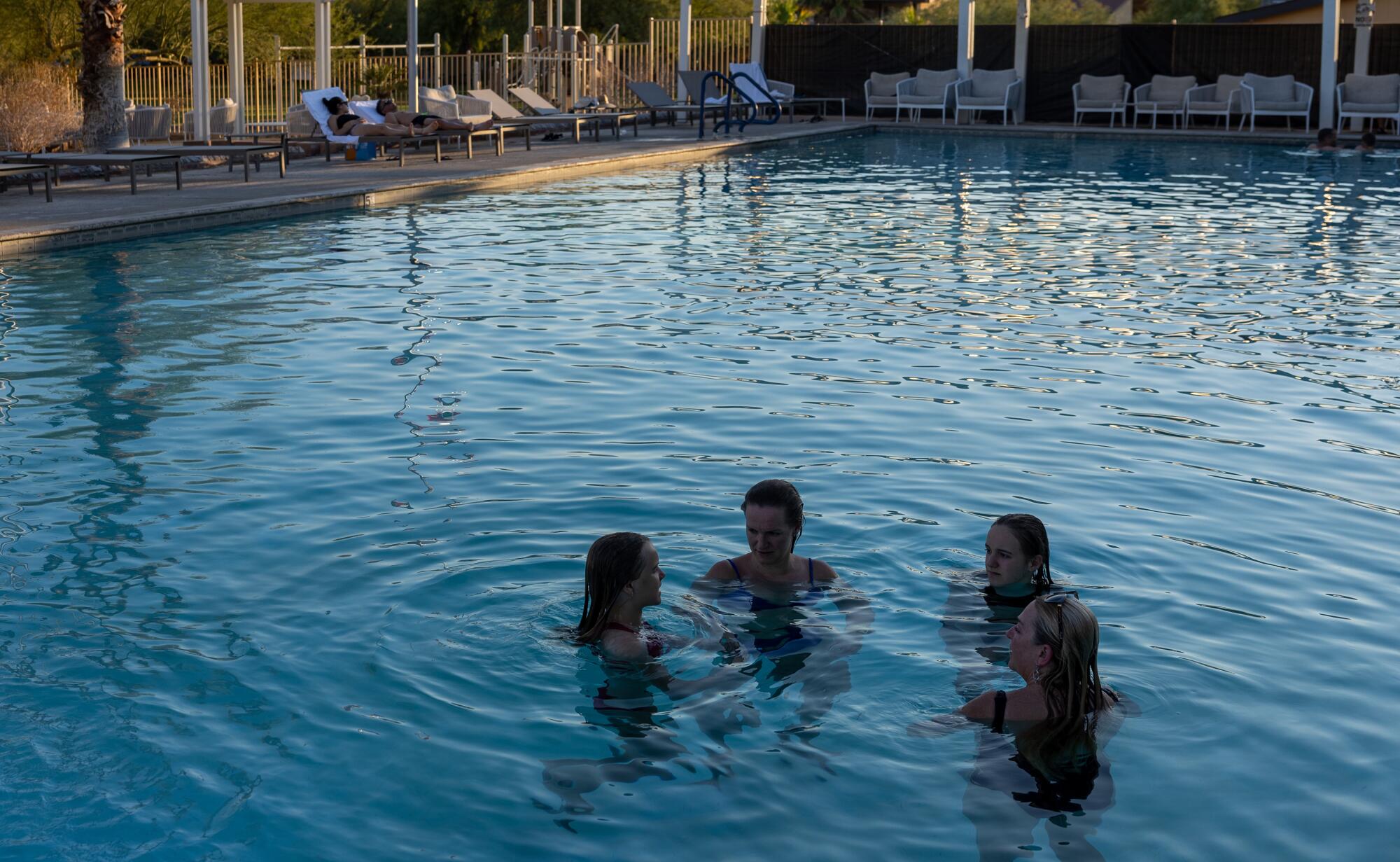
Visitors take a late-afternoon swim in the pool at Furnace Creek, where temperatures lingered in the 120s inside Death Valley National Park.
For Jurado, a safe visit looks like taking refuge in air conditioning during the hottest parts of the day and experiencing the heat in short five-minute intervals. The vast majority of visitors take this approach. If they hike at all, it’s early in the morning, and the car never leaves their sight. The rest of the day, they spend hanging at the hotel or by the pool — or they leave the park.
Although it might be possible for someone to — wrongly — convince themselves that a 90-degree heat wave in the city won’t affect them personally, it’s much harder to do that in a Death Valley heat wave.
Ironically, this makes Jurado worry more about cooler days in the park, when visitors may not be most on guard. When hikers died within days of each other a few years back, it was an unseasonably cool 105 degrees in the park.
“It’s that level of heat where people are like, ‘Oh, it’s not Death Valley hot, I can hike longer — I can take more risks,’” Jurado said.
World News
Women in Iran are going without hijabs as the 2nd anniversary of Mahsa Amini’s death approaches

DUBAI, United Arab Emirates (AP) — On the streets of Iranian cities, it’s becoming more common to see a woman passing by without a mandatory headscarf, or hijab, as the second anniversary of the death of Mahsa Amini and the mass protests it sparked approaches.
There’s no government official or study acknowledging the phenomenon, which began as Iran entered its hot summer months and power cuts in its overburdened electrical system became common. But across social media, videos of people filming neighborhood streets or just talking about a normal day in their life, women and girls can be seen walking past with their long hair out over their shoulders, particularly after sunset.
This defiance comes despite what United Nations investigators describe as “expanded repressive measures and policies” by Iran’s theocracy to punish them — though there’s been no recent catalyzing event like Amini’s death to galvanize demonstrators.
The country’s new reformist President Masoud Pezeshkian campaigned on a promise to halt the harassment of women by morality police. But the country’s ultimate authority remains the 85-year-old Supreme Leader Ayatollah Ali Khamenei, who in the past said “unveiling is both religiously forbidden and politically forbidden.”
For some observant Muslim women, the head covering is a sign of piety before God and modesty in front of men outside their families. In Iran, the hijab — and the all-encompassing black chador worn by some — has long been a political symbol as well.
“Meaningful institutional changes and accountability for gross human rights violations and crimes under international law, and crimes against humanity, remains elusive for victims and survivors, especially for women and children,” warned a U.N. fact-finding mission on Iran on Friday.
Amini, 22, died on Sept. 16, 2022, in a hospital after her arrest by the country’s morality police over allegedly not wearing her hijab to the liking of the authorities. The protests that followed Amini’s death started first with the chant “Women, Life, Freedom.” However, the protesters’ cries soon grew into open calls of revolt against Khamenei.
A monthslong security crackdown that followed killed more than 500 people and saw over 22,000 detained.
Today, passersby on the streets of Tehran, whether its tony northern suburbs for the wealthy or the working-class neighborhoods of the capital’s southern reaches, now routinely see women without the hijab. It particularly starts at dusk, though even during the daylight on weekends women can be seen with their hair uncovered at major parks.
Online videos — specifically a sub-genre showing walking tours of city streets for those in rural areas or abroad who want to see life in the bustling neighborhoods of Tehran — include women without the hijab.
Something that would have stopped a person in their tracks in the decades follwing the 1979 Islamic Revolution now goes unacknowledged.
“My quasi-courage for not wearing scarves is a legacy of Mahsa Amini and we have to protect this as an achievement,” said a 25-year-old student at Tehran Sharif University, who gave only her first name Azadeh out of fear of reprisal. “She could be at my current age if she did not pass away.”
The disobedience still comes with risk. Months after the protests halted, Iranian morality police returned to the streets.
There have been scattered videos of women and young girls being roughed up by officers in the time since. In 2023, a teenage Iranian girl was injured in a mysterious incident on Tehran’s Metro while not wearing a headscarf and later died in hospital. In July, activists say police opened fire on a woman fleeing a checkpoint in an attempt to avoid her car being impounded for her not wearing the hijab.
Meanwhile, the government has targeted private businesses where women are seen without their headscarves. Surveillance cameras search for women uncovered in vehicles to fine and impound their cars. The government has gone as far as use aerial drones to monitor the 2024 Tehran International Book Fair and Kish Island for uncovered women, the U.N. said.
Yet some feel the election of Pezeshkian in July, after a helicopter crash killed Iranian hard-line President Ebrahim Raisi in May, is helping ease tensions over the hijab.
“I think the current peaceful environment is part of the status after Pezeshkian took office,” said Hamid Zarrinjouei, a 38-year-old bookseller. “In some way, Pezeshkian could convince powerful people that more restrictions do not necessarily make women more faithful to the hijab.”
On Wednesday, Iran’s Prosecutor General Mohammad Movahedi Azad warned security forces about starting physical altercations over the hijab.
“We prosecuted violators, and we will,” Movahedi Azad said, according to Iranian media. “Nobody has right to have improper attitude even though an individual commits an offense.”
While the government isn’t directly addressing the increase in women not wearing hijabs, there are other signs of a recognition the political landscape has shifted. In August, authorities dismissed a university teacher a day after he appeared on state television and dismissively referred to Amini as having “croaked.”
Meanwhile, the pre-reform newspaper Ham Mihan reported in August on an unpublished survey conducted under the supervision of Iran’s Ministry of Culture and Islamic Guidance that found the hijab had become one of the most important issues in the country — something it hadn’t seen previously.
“This issue has been on people’s minds more than ever before,” sociologist Simin Kazemi told the newspaper.
___
Associated Press writers Nasser Karimi and Amir Vahdat in Tehran, Iran, contributed to this report.
World News
Wordle Answer for Today, September 14, 2024

If you’re looking for the Wordle answer for September 14, 2024 read on. We’ll share some clues, tips, and strategies, and finally the solution. Today’s puzzle is easier; I got it in four. Beware, there are spoilers below for September 14, Wordle #1,183! Keep scrolling if you want some hints (and then the answer) to today’s Wordle game.
How to play Wordle
Wordle lives here on the New York Times website. A new puzzle goes live every day at midnight, your local time.
Start by guessing a five-letter word. The letters of the word will turn green if they’re correct, yellow if you have the right letter in the wrong place, or gray if the letter isn’t in the day’s secret word at all. For more, check out our guide to playing Wordle here, and my strategy guide here for more advanced tips. (We also have more information at the bottom of this post, after the hints and answers.)
Ready for the hints? Let’s go!
Does today’s Wordle have any unusual letters?
We’ll define common letters as those that appear in the old typesetters’ phrase ETAOIN SHRDLU. (Memorize this! Pronounce it “Edwin Shirdloo,” like a name, and pretend he’s a friend of yours.)
They’re almost all common letters from our mnemonic today! Only one isn’t, and it’s fairly common.
Can you give me a hint for today’s Wordle?
Not narrow.
Does today’s Wordle have any double or repeated letters?
There are no repeated letters today.
How many vowels are in today’s Wordle?
There are two vowels.
What letter does today’s Wordle start with?
Today’s word starts with B.
What letter does today’s Wordle end with?
Today’s word ends with D.
What is the solution to today’s Wordle?
Ready? Today’s word is BROAD.
How I solved today’s Wordle
I started with RAISE and TOUCH followed by BLOND, which made it clear that BROAD was the solution.
Wordle 1,183 4/6 🟨🟨⬛⬛⬛ ⬛🟨⬛⬛⬛ 🟩⬛🟩⬛🟩 🟩🟩🟩🟩🟩
Yesterday’s Wordle answer
Yesterday’s Wordle was easier. The hint was “jarring to the senses” and the answer contained all common letters.
The answer to yesterday’s Wordle was HARSH.
A primer on Wordle basics
The idea of Wordle is to guess the day’s secret word. When you first open the Wordle game, you’ll see an empty grid of letters. It’s up to you to make the first move: type in any five-letter word.
Now, you can use the colors that are revealed to get clues about the word: Green means you correctly guessed a letter, and it’s in the correct position. (For example, if you guess PARTY, and the word is actually PURSE, the P and R will be green.)
-
Yellow means the letter is somewhere in the word, but not in the position you guessed it. (For example, if you guessed PARTY, but the word is actually ROAST, the R, A and T will all be yellow.)
-
Gray means the letter is not in the solution word at all. (If you guessed PARTY and everything is gray, then the solution cannot be PURSE or ROAST.)
With all that in mind, guess another word, and then another, trying to land on the correct word before you run out of chances. You get six guesses, and then it’s game over.
The best starter words for Wordle
What should you play for that first guess? The best starters tend to contain common letters, to increase the chances of getting yellow and green squares to guide your guessing. (And if you get all grays when guessing common letters, that’s still excellent information to help you rule out possibilities.) There isn’t a single “best” starting word, but the New York Times’s Wordle analysis bot has suggested starting with one of these:
-
CRANE
-
TRACE
-
SLANT
-
CRATE
-
CARTE
Meanwhile, an MIT analysis found that you’ll eliminate the most possibilities in the first round by starting with one of these:
-
SALET
-
REAST
-
TRACE
-
CRATE
-
SLATE
Other good picks might be ARISE or ROUND. Words like ADIEU and AUDIO get more vowels in play, but you could argue that it’s better to start with an emphasis on consonants, using a starter like RENTS or CLAMP. Choose your strategy, and see how it plays out.
How to win at Wordle
We have a few guides to Wordle strategy, which you might like to read over if you’re a serious student of the game. This one covers how to use consonants to your advantage, while this one focuses on a strategy that uses the most common letters. In this advanced guide, we detail a three-pronged approach for fishing for hints while maximizing your chances of winning quickly.
The biggest thing that separates Wordle winners from Wordle losers is that winners use their guesses to gather information about what letters are in the word. If you know that the word must end in -OUND, don’t waste four guesses on MOUND, ROUND, SOUND, and HOUND; combine those consonants and guess MARSH. If the H lights up in yellow, you know the solution.
One more note on strategy: the original Wordle used a list of about 2,300 solution words, but after the game was bought by the NYT, the game now has an editor who hand-picks the solutions. Sometimes they are slightly tricky words that wouldn’t have made the original list, and sometimes they are topical. For example, FEAST was the solution one Thanksgiving. So keep in mind that there may be a theme.
Wordle alternatives
If you can’t get enough of five-letter guessing games and their kin, the best Wordle alternatives, ranked by difficulty, include:
-
Dordle and Quordle, which ask you to play two (Dordle) or four (Quordle) puzzles at the same time, with the same guesses. There is also Octordle, with eight puzzles, and Sedecordle, with 16.
-
Waffle, which shows you several five-letter words, scrambled in a grid; you play by swapping the letters around until you solve.
-
Absurdle, which changes the solution after each guess, but needs to stay consistent with its previous feedback. You have to strategically back it into a corner until there is only one possible word left; then you guess it, and win.
-
Squabble, in which you play Wordle against other people with a timer running. You take damage if you spend too much time between guesses; winner is the last one standing.
-
Antiwordle, in which you are trying not to guess the day’s solution. You’re required to reuse any letters that you (oops) guessed correctly, so the longer it takes you, the better you are at the game.
World News
Aaron Judge sends Yankee Stadium into a frenzy after smashing huge grand slam vs. Red Sox


Aaron Judge brought Yankee Stadium to its feet on Friday night with a single swing of the bat.
The Yankee captain and former MVP came up with the bases loaded and no one in the bottom of the seventh inning. The Yankees trailed the Boston Red Sox 4-1.
Then Judge crushed a 2-0 pitch to deep right field for the type of home run that the crowd knows is gone before it leaves the infield. It gave the Yankees a 5-4 lead. The Yankees held the lead to win, taking the first two games of the series against Boston and extending their lead in the AL East over the Baltimore Orioles by three games.
CLICK HERE FOR MORE SPORTS COVERAGE ON FOXNEWS.COM
The Yankee Stadium crowd erupted to one of its loudest cheers of the year, as the fans celebrated their star player’s big moment over their hated rival.
For Judge, the grand slam actually broke one of his rare home run droughts. Going into Friday night’s game Judge had not hit a home run in 16 straight games, which was the longest stretch of his career without one. It’s a stretch that came amid, arguably, Judge’s best hitting season yet.
EX-YANKEES INFIELDER TYLER AUSTIN SUFFERS FREAK INJURY WITH JAPANESE CLUB
With the grand slam in hand, Judge collected the 52nd home run of the season, improving his average to .321 with a 1.143 OPS and 130 RBI.
But before Friday, hfter he hit two home runs against the Colorado Rockies on Aug. 26, the six-time All-Star is hitting .204 (11 for 54) with 22 strikeouts in his net 15 games.
The prior longest homerless streak of Judge’s career came during his rookie season, when he did not leave the yard in 15 games from Aug. 17 through Sept. 2 in 2017.
CLICK HERE TO GET THE FOX NEWS APP
Before his current drought, Judge was on a torrid pace, hitting nine home runs over 10 prior games, making people wonder if he had a chance to break his own American League record for most home runs in a season that he set in 2022 with 62 home runs.
Still Judge is currently in the driver’s seat to win his second American League MVP award in three years.
Follow Fox News Digital’s sports coverage on X, and subscribe to the Fox News Sports Huddle newsletter.
-

 African History5 years ago
African History5 years agoA Closer Look: Afro-Mexicans 🇲🇽
-

 African History8 months ago
African History8 months agoBlack History Facts I had to Learn on My Own pt.6 📜
-

 African History5 years ago
African History5 years agoA Closer Look: Afro-Mexicans 🇲🇽
-

 African History1 year ago
African History1 year agoMajor African Tribes taken away during the Atlantic Slave Trade🌍 #slavetrade #africanamericanhistory
-

 African History2 years ago
African History2 years agoCameroon 🇨🇲 World Cup History (1962-2022) #football #realmadrid #shorts
-

 African History1 year ago
African History1 year agoWhat did Columbus Find in 1493? 🤯🔥🔥 #history #civilization #mesoamerica #africa #kemet
-

 African History8 months ago
African History8 months agoBlack History Inventors: Mary Kenner 🩸
-

 African History1 year ago
African History1 year agoOrigin Of ‘Cameroon’ 🇨🇲😳#africa


